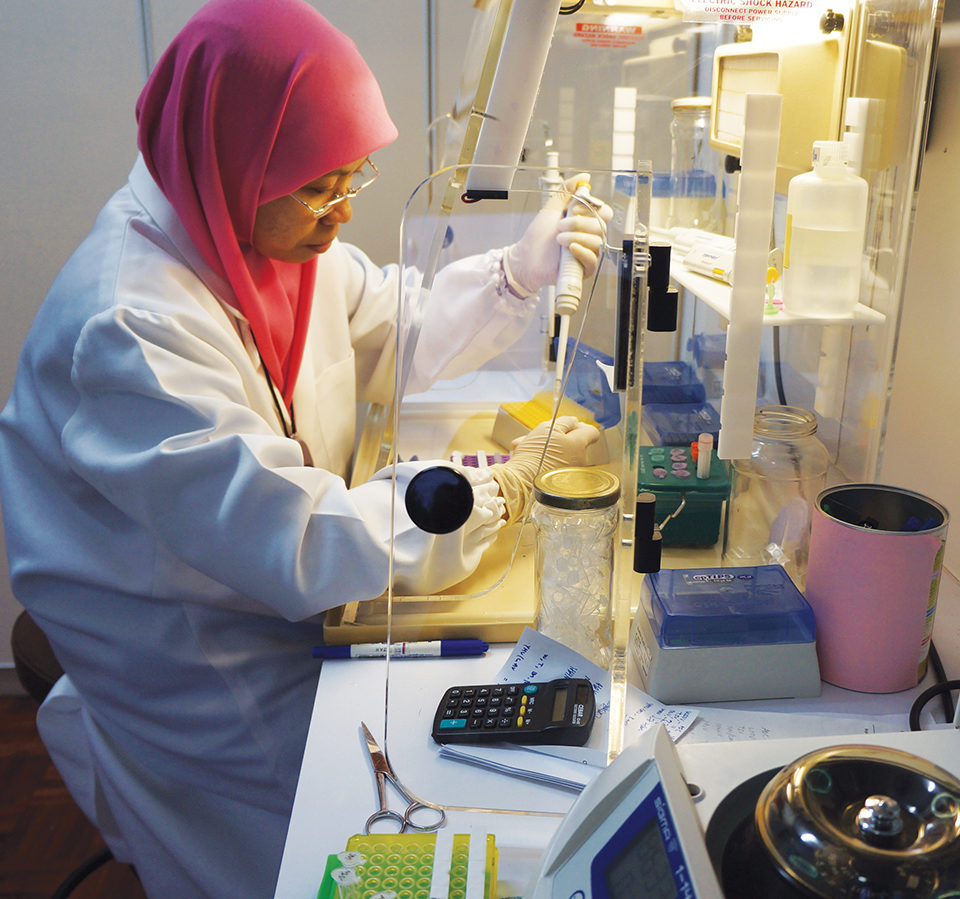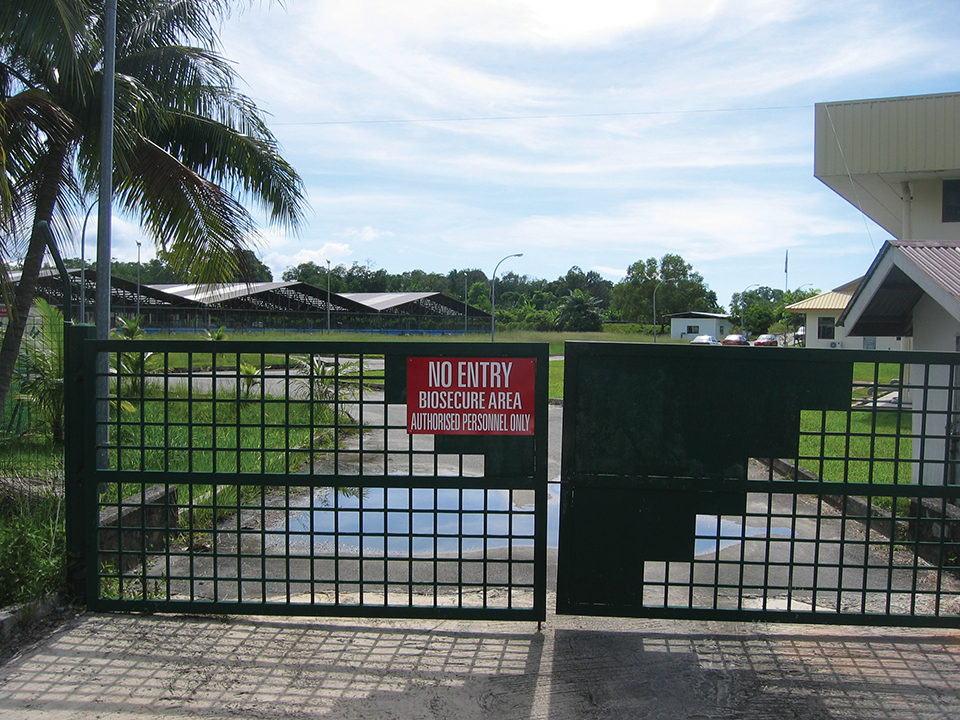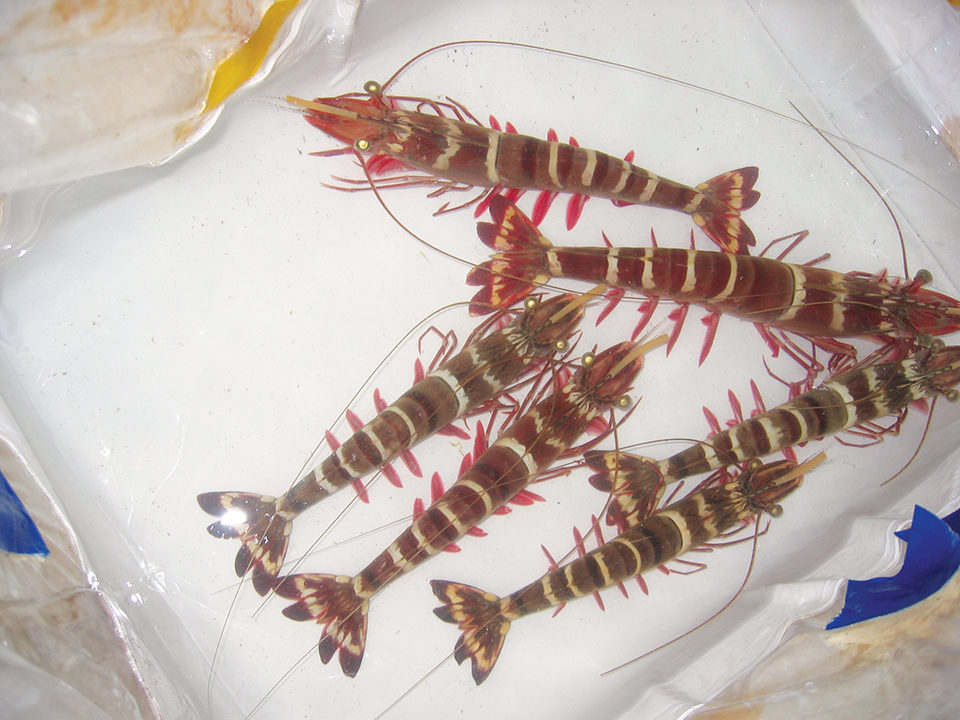Health program for SPF stocks

Multiple diseases continue to plague the shrimp aquaculture industry worldwide, causing major economic losses. Many farmers still rely on wild spawners of black tiger shrimp, which yield inconsistent results due to multiple diseases that can cause mortality, slow growth, size variation, poor reproductive performance and product rejection.
Specific pathogen-free stocks
The approaches used to reduce the risk of disease can be broadly categorized as those that exclude pathogens and those that increase the immunity of the host. Both approaches are valid and are often used in combination.
One of the most important steps in excluding pathogens is to begin with specific-pathogen free (SPF) stocks. This has been the basis for worldwide adoption of SPF Litopenaeus vannamei. The establishment of SPF black tiger shrimp (Penaeus monodon) and their commercial availability to farmers is a much-awaited development in shrimp culture.
Since 2000, Brunei Darussalam has been culturing SPF Pacific blue shrimp (P. stylirostris). To provide a higher-value species for Brunei shrimp farmers, the Department of Fisheries (DOF) of Brunei Darussalam joined with Integrated Aquaculture International in 2007 to develop SPF P. monodon.
The breeding work is part of a five-year project to develop advanced technology for the production of large black tiger shrimp. By combining comprehensive disease diagnostic services, selective breeding, advanced feeds and highly efficient grow-out methods, the project could help lead to a resurgence of black tiger shrimp in Asia.
Health laboratory
Detection of shrimp diseases requires both molecular and histological testing methods. Thus, a prerequisite for the development of SPF stocks is a competent laboratory for disease testing.
The Aquatic Animal Health Services Centre (AAHSC) of the Brunei DOF, established in 2006, is the heart of the collaboration to develop SPF P. monodon for commercial production. The AAHSC also serves the needs of the country’s aquaculture industry, including shrimp farmers culturing P. stylirostris and those engaged in cage farming high-value marine fish species.
The AAHSC is equipped with state-of-the-art equipment to ensure rapid processing and timely release of diagnostic results that serve as the basis for decision making about the development and surveillance of SPF families. In a breeding program, it is necessary to determine as quickly as possible which shrimp to discard and which to retain.
The center also has a microbiology laboratory to ensure that diagnostic needs for bacterial, fungal and parasitic diseases are adequately met. Finally, a supporting water quality analysis unit helps evaluate the environmental conditions at the farms and hatcheries where samples are drawn.
In August 2010, the AAHSC participated in a ring test conducted by the University of Arizona to test the proficiency of laboratory personnel and the PCR methods used. Blind samples prepared in the United States were sent to Brunei for analysis. AAHSC passed the ring testing with satisfactory results.

Excluded diseases, pathogens
More than 20 viruses have been reported to infect marine shrimp, with nine responsible for substantial economic losses: white spot syndrome virus, Taura syndrome virus, infectious myonecrosis virus, yellowhead virus, infectious hypodermal and hematopoietic necrosis virus, gill-associated virus, monodon baculovirus, hepatopancreatic parvovirus and Mourilyan virus.
All nine of these viruses are excluded from the P. monodon stocks developed for this SPF breeding program. In addition, any batch of shrimp that shows lymphoid organ spheroids by histology is discarded, because many viral diseases of penaeids are reportedly related to this spheroid formation. Histology also allows detection of microsporidians, gregarines and other parasites on the exclusion list.
The AAHSC has played a vital role in the development of SPF founder families. The movement of shrimp from primary to secondary quarantine, and to the nucleus breeding center is dependent on the results of health testing by PCR and histopathology. All screening protocols and biosecurity procedures for maintaining the health of founder families and their progeny have become standard operating procedures.
Primary, secondary quarantine
The SPF development process begins in the primary quarantine facility, where adult black tiger shrimp collected by offshore trawling in the coastal waters of Brunei Darussalam are induced to spawn. All spent spawners are sacrificed for PCR and histology. Only spawns from clean mothers are transferred to the secondary quarantine facility, where they are reared to postlarvae (P.L.) and undergo another health screening. Upon reaching P.L.70 or a weight of about 3 g, samples are taken for PCR and evaluation by histology.
If histopathology determines the presence of microsporidian parasites, gregarines or the fungus Fusarium solani, affected animals are immediately discarded from the breeding program, and the tank and equipment are disinfected. One of the successes of the SPF program is that no viral diseases have been detected beyond primary quarantine. This is due to the stringent screening and surveillance of stocks combined with the biosecurity protocols implemented.
Upon reaching juvenile stage, shrimp are sampled for both PCR and histology during bimonthly raceway transfers. Surveillance is targeted on the smallest shrimp in the lot and/or those showing gross signs of abnormality in appearance or behavior.
Two years of continued health screening through secondary and tertiary quarantine processes are required to ensure the SPF candidate offspring remain free of viral agents. SPF P. monodon established in Brunei Darussalam have been transferred to a breeding program where strict biosecurity procedures and continual health surveillance are implemented to ensure they remain free of pathogens.

SPF milestone
In May 2009, the Brunei P. monodon SPF program achieved the milestone of two years of disease testing for many F2 lines of P. monodon. A subset of F2 P. monodon from the nucleus breeding facility at the Aquaculture Development Center was sent to Dr. Donald Lightner’s laboratory at the University of Arizona in the United States for PCR confirmation. All animals had undetectable levels of viruses, supporting the AAHSC lab results.
By continuing to follow these stringent standard operating procedures in the acquisition and rearing of stocks, 40 founder families have been classified as SPF P. monodon.
Performance results
It is a challenge to isolate and maintain SPF populations of P. monodon, given the long list of pathogens to be excluded and the frequency of infection of wild populations. Nevertheless, the program in Brunei Darussalam demonstrates that development and maintenance of SPF stocks is an achievable goal, provided there is a long-term commitment to strict biosecurity and continual health surveillance.
The SPF stocks from the program have yielded outstanding performance in 0.25-ha intensive ponds, with average yields of 6.1 metric tons/ha, average harvest size of 50.1 grams, average growth of 2.8 grams/week and an average feed-conversion ratio of 1.49.
(Editor’s Note: This article was originally published in the July/August 2012 print edition of the Global Aquaculture Advocate.)
Authors
-
Celia L. Pitogo
Integrated Aquaculture International
3303 West Twelfth Street
Hastings, Nebraska 68902-0609 USA -
Laila Hamid
Department of Fisheries
Brunei Darussalam -
Wanidawati Tamat
Department of Fisheries
Brunei Darussalam -
Chris Howell
Integrated Aquaculture International
3303 West Twelfth Street
Hastings, Nebraska 68902-0609 USA
Tagged With
Related Posts

Health & Welfare
Brunei project develops technology for large black tiger shrimp production, part 3
Specific pathogen-free offspring developed from founder populations of P. monodon collected from Brunei coastal waters were introduced into a biosecure breeding program, where they have been reared to the fifth generation using family-based selection for reproduction and growth.

Health & Welfare
Brunei project develops technology for large black tiger shrimp production, part 4
Nutrition research run in conjunction with the breeding program ensures that cost-effective feeds are optimized for shrimp performance for a five-year project undertaken in Brunei Darussalam to develop advanced technology for production of large black tiger shrimp.

Health & Welfare
Brunei project develops technology for large black tiger shrimp production, part 5
The final article in a series about a project in Brunei to develop technology for production of black tiger shrimp focuses on the development of advanced grow-out ponds and practices with enhanced systems for biosecurity, sludge removal, water reuse, energy efficiency, automatic feeding and mechanical harvesting.

Health & Welfare
Brunei project develops technology for large black tiger shrimp production, part 1
A five-year project was undertaken in Brunei Darussalam to develop advanced technology for the production of large black tiger shrimp. A combination of technologies has enabled efficient production of large-sized black tiger shrimp, which could lead to a resurgence of this species in Asia.


